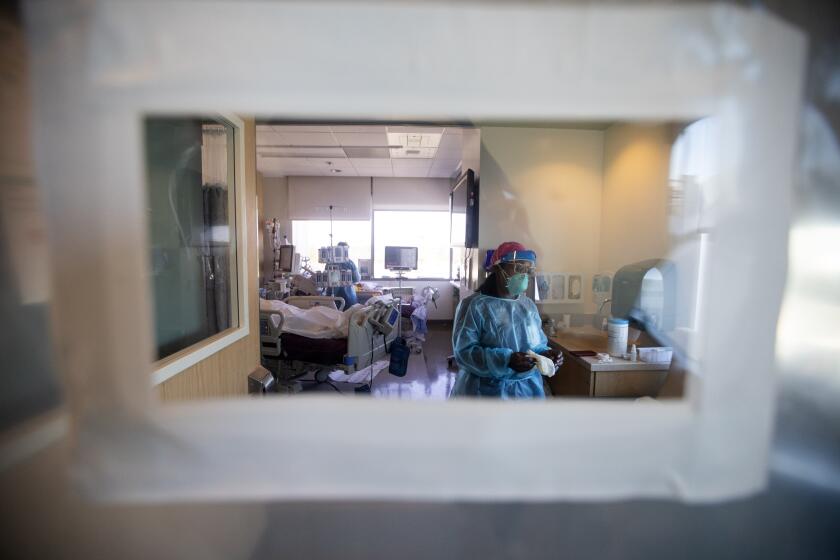Scientists see path for the coronavirus to invade the brain
- Share via
Scientists experimenting in the lab have found that the coronavirus that causes COVID-19 is capable of infecting two types of brain cells — neurons and astrocytes.
The findings could shed light on a possible reason for the bewildering array of neurological symptoms that follow some COVID-19 survivors even after they recover.
COVID-19 is best known as a respiratory disease, but for many victims, it also triggers an array of problems including memory lapses, fatigue and a certain sluggish, fuzzy feeling often referred to as “brain fog.”
Scientists have been trying to understand why and how a coronavirus infection causes these issues in the brain, said study leader Diana Cruz-Topete, a molecular endocrinologist at Louisiana State University Health Shreveport.
Is the virus causing these problems indirectly — for example, by causing significant inflammation or clotting? Or is it causing them directly, by infecting cells in the brain?
Theoretically, the latter would be a tricky proposition since it would depend on two things. The first is whether the SARS-CoV-2 virus can attack cells of the central nervous system. The second is whether the virus can gain access to the brain, which is protected by a semipermeable barrier that can block out pathogens and other harmful particles while still allowing nutrients and other key molecules to make it through.
Cruz-Topete and her colleagues focused on the first issue. They examined cells typically found in the brain and spinal cord to see if they were vulnerable to infection.
One-third of COVID-19 survivors were diagnosed with a psychiatric or neurological condition within six months of being infected with the coronavirus.
The SARS-CoV-2 virus attacks human cells by targeting what are known as ACE2 receptors. These receptors are proteins that cover the surface of many types of cells, including those of the lungs, heart, kidneys and liver. But it’s been unclear whether cells in the brain and spinal cord even have the ACE2 receptors the coronavirus needs to mount an invasion.
To find out, the researchers needed to know whether brain cells express ACE2 receptors and, if so, whether they can be infected.
The scientists took human neural cells grown in laboratory dishes and studied the RNA and proteins they produced to look for evidence that ACE2 was being expressed. They examined neurons as well as astrocytes, supportive cells in the brain and spinal cord that outnumber neurons by more than 5 to 1.
These star-shaped cells help maintain several key functions in the central nervous system and maintain the semipermeable boundary known as the blood-brain barrier. They also ferry nutrients from the bloodstream to neurons and prevent dangerous substances from getting in.
“Astrocytes are cells that are in close contact with the blood-brain barrier,” Cruz-Topete said. If the virus were somehow to breach the barrier, astrocytes — if they were vulnerable to infection — would be among its most easily reached targets.
Both astrocytes and neurons did express the ACE2 receptor, the scientists found. The next step was to see whether the brain cells could actually be infected.
To do so, they used a surrogate virus modified to express the spike protein — the one that allows the coronavirus to “unlock” the ACE2 receptor and enter a cell. The engineered virus also expressed a green fluorescent protein that made it easy to spot after infecting a cell.
The scientists unleashed their virus on both astrocytes and neurons and found that both types of brain cells can be infected with SARS-CoV-2. However, the astrocytes were significantly less likely than neurons to become infected.
The researchers aren’t sure why that would be. Regardless of the reason, since there are so many of them, they provide the virus ample opportunity to invade and replicate.
Once the astrocytes are infected, they could potentially be used as a steppingstone for the virus to reach more vulnerable neurons, the researchers said. That could explain many of the neurologic symptoms seen in COVID-19 patients, including loss of sense of smell and taste, disorientation, psychosis and stroke, the scientists said.
The findings were presented last week at the American Physiological Society’s annual Experimental Biology meeting.
The study has some limitations. For example, the experiments in the lab may not reflect what the virus does in the complex environment of a living body. A recent report in JAMA Psychiatry noted that SARS-CoV-2 viral particles have been found in brain vascular endothelium — the organ that makes up the blood-brain barrier — but not in neurons or astrocytes.
Dr. Maura Boldrini, a psychiatrist and neuroscientist at Columbia University who was not involved in the research, said a big question remains: Even if brain cells are vulnerable to infection, how exactly could the virus cross the blood-brain barrier?
“The main studies have shown that we don’t think there is a lot of penetration of the virus itself in the brain except in specific places,” said Boldrini, lead author of the JAMA Psychiatry paper.
Cells hijacked by the coronavirus grow long, streaming tentacles to reach out to new victims, scientists found. This could complicate the search for a vaccine.
Those places include the area postrema in the brainstem, which lies outside the blood-brain barrier because its job is to detect toxins and trigger vomiting in response. Perhaps the coronavirus is able to take advantage of this back door or another like it.
“There are other areas around the base of the skull where there is a possibility [for] entry,” Boldrini said, though she added there hasn’t been a lot of evidence so far indicating that the virus penetrates much deeper into the brain.
When it comes to COVID-19’s long-term neurological effects, Boldrini said another question needs answering: how brain function is affected by the inflammation triggered by the disease. That inflammation amounts to an indirect attack on the brain.
It’s a complicated question that will require further study to answer. Cruz-Topete said her team plans to look at samples of brain tissue, and eventually move on to examine the behavior of COVID-19 survivors.
“We want to see if there is an association between the changes we have seen and actual changes in behavior in people who have suffered the disease,” she said.








